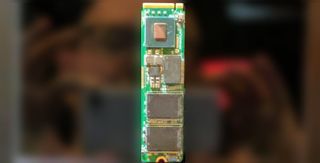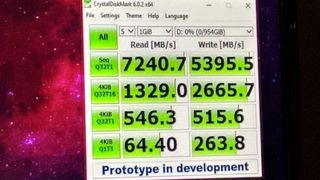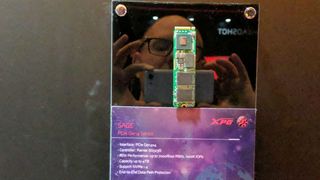Adata Shows Off SSD with 1 Million IOPS, 7,000 MBps Reads
Due out later this year, the XPG Sage will use a brand new controller and operate over PCI Gen 4.

If an M.2 SSD that reads at 3,500 MBps seems a little slow to you, Adata has good news. Here at CES 2020, the company unveiled the XPG Sage, an upcoming PCIe Gen 4 SSD that promises read and write speeds of over 7,000 and 6,000 MBps, along with 1 million / 800K IOPS read and writes. Due out later this year for an undetermined price, the Sage is among the first to use Innogrit's Rainier controller.
At its CES suite, Adata showed some preliminary CrystalDisk results from the Sage. The demo unit managed sequential read and writes of 7,240 and 5,395 MBps respectively. However, an Adata product manager said he expects the write rate to increase to over 6,000 MBps by the time the firmware is finalized.

The Innogrit Rainier (IG5236) controller promises significant speed and IOPS improvements over the Phison E16, the controller found in all the current-gen PCIe 4.0 SSDs. The Corsair MP600, which uses the E16 controller, is rated for read / writes of 4,950 / 4,250 MBps, about 25 percent less than the Rainier-powered XPG Sage. Additionally Corsair's SSD is rated for only 680,000 / 600,000 IOPS, 30 to 40 percent less than the Sage's 1 million / 800,000 read / write IOPS.
Innogrit is a new name in the SSD controller space, but the specs on its Rainier IG5236 are impressive. It uses 8 channels, with a 16 / 12nm TSMC FinFET manufacturing process, and can support up to 16TB of storage. The Sage itself will be available in capacities of up to 4TB.

An Adata representative said that the Sage has a full 4GB of DRAM cache. As part of the XPG gaming line, it will have an attractive heatspreader, but the company didn't have one to show us just yet.
Given the fluctuation in NAND prices, Adata could not share target pricing. A rep did say that we should expect to see the Sage sometime later this year, perhaps around the Computex (May / June) time frame.
Stay on the Cutting Edge
Join the experts who read Tom's Hardware for the inside track on enthusiast PC tech news — and have for over 25 years. We'll send breaking news and in-depth reviews of CPUs, GPUs, AI, maker hardware and more straight to your inbox.
-
Quaddro Holy moly, that thing is even faster than my system memory... (i'm still using lga 775 ddr2 in one of my computers)Reply -
herrwizo It would be nice to see some improvements in random read department as well. With the exception of Optane, virtually all NVMe drives from past few years hover around 60MB/s mark.Reply -
Xajel Holy cow, this is even faster than Samsung's PCIe 4.0 drives... hopefully it will come at a good price and good endurance also.Reply
Thought Samsung only revealed their Pro drive, which usually use MLC and not TLC, usually these will be priced higher already as they're more reliable. But I'm wondering about the Evo version too. I don't think the evo will be faster than the pro anyway. -
djayjp ReplyQuaddro said:Holy moly, that thing is even faster than my system memory... (i'm still using lga 775 ddr2 in one of my computers)
Actually that's not true. Random read is only 64MB/s, highlighting the still huge disparity between flash and ram. -
drinking12many Also consider they are only using a 1GB file that will fully sit in the DRAM on drive.Reply
Most Popular



